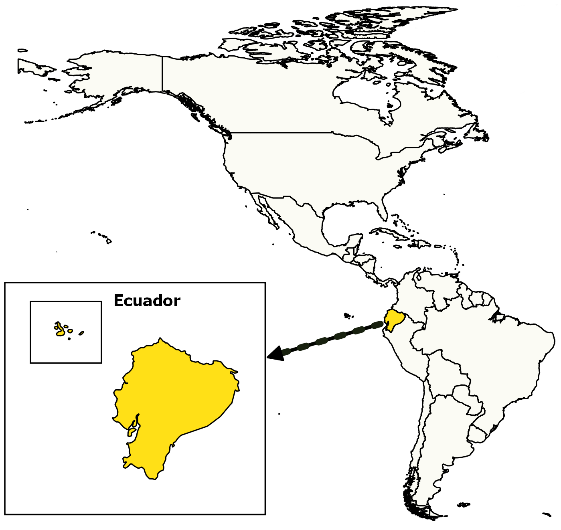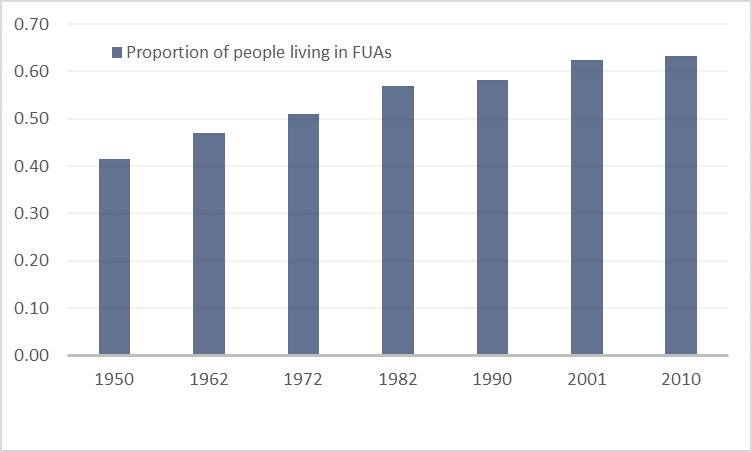 Volume
5, Number 3, 2018, 39–48 journal homepage:
region.ersa.org
Volume
5, Number 3, 2018, 39–48 journal homepage:
region.ersa.orgDOI: 10.18335/region.v5i3.235
Urbanization in Ecuador: An overview using the
Functional Urban Area definition
1 Universitat de Barcelona, Barcelona, Spain2 Escuela Politécnica Nacional, Quito, Ecuador Received: 28 December 2017/Accepted: 16 October 2018
Abstract. This paper presents an overview of the urbanization in Ecuador during the period 1950-2010. First, it is shown that Ecuador does not follow a suitable definition of urban areas, then the idea of Functional Urban Areas (FUAs) definition is introduced. In this line, 28 FUAs in Ecuador are analyzed. When Ecuadorian FUAs population evolution over time is explored, it is possible to observe that the urbanization of Ecuador had its peak between 1960 and 1980. Moreover, the highest increase of population in recent decades is mostly driven by the urban growth of small FUAs. In addition, the analysis suggests that the FUAs in Ecuador are in line with the size and structure of the FUAs of a similar developing country, Colombia, and the whole OECD sample of FUAs. Finally, it is pointed that the population of Ecuador is concentrated in the FUAs of metropolitan size (1.5 million of inhabitants or more), which are below the average of the metropolitan areas of the OECD.
JEL classification: R12, R23
Key words: Developing economies, Ecuador, FUAs, OECD, Urbanization
1 Introduction
Cities are the engines of a country’s economic activity. The global urbanization trend over the last decade shows, without doubt, that the world is more urban than rural (Pesaresi et al. 2016). However, how to define “urban” has been an important concern to different international organizations and researchers. In fact, one of the most ambitious goals of the Organization for Economic Co-operation and Development (OECD) and European Commission is to identify and standardize the international comparability of urban areas around the world on the denomination of Functional Urban Areas (FUAs) (OECD 2013, Brezzi et al. 2012).
The FUAs have opened the international comparison of the urbanization to more than 30 OECD and non-OECD countries, and therefore, they allow analysis of the urban spatial structure and its trend across countries under a standardized definition of urban areas (Veneri 2017). The importance of building the FUAs relies on having a new point of view of the urbanization, which becomes important for developing economies because differences in the urbanization between developed and developing economies is remarkable. The urbanization in developing countries is characterized by extreme poverty and low quality institutions (Glaeser, Henderson 2017). Thus, the FUAs have allowed international organizations and governments to consider public policies for better urban planning.
As for the FUAs construction, the FUAs require population and commuting data. However, the lack of necessary data, especially in developing countries, has become a barrier in their identification process. In those cases, several approaches have been used to identify them where there is not standard data available. For example, the OECD applies an alternative method to identify the FUAs in China (OECD 2015). Although, the Chinese FUAs identification does not have the standard methodological approach, they allowed understanding of the urbanization system and economic performance of the Chinese functional urban areas. The result shows that the Chinese FUAs are growing more concentrated with 15 urban areas having more than 10 million inhabitants.
Recently, Obaco et al. (2017) also proposed an alternative approach to identify FUAs. This methodology is applied in Ecuador. However, FUAs identified in Ecuador have not been compared with the international FUAs in the OECD database, differing from was has been done for the majority of other cases. The underlying reason is the fact that Ecuador is not member of the OECD. Thus, this paper contributes analysis of the evolution of urbanization in Ecuador under the FUAs definition and compares the FUAs in Ecuador with the international context of the OECD. Additionally, the contribution of this work to the literature of the FUAs is twofold. First, the comparison of the FUAs of Ecuador in the international context will show whether the Ecuadorian FUAs, based on a different methodological approach, have a similar urban structure of the FUAs of the OECD based on its standard approach. Indeed, comparing FUAs allows further analysis when anomalies in the patterns of countries with similar characteristics are found. Second, this paper will also check the evolution of Ecuadorian urbanization applying a different concept of urbanization.
Results suggest that FUAs in Ecuador are in line with the size and structure of the FUAs of a similar developing country such as Colombia, and the whole OECD sample of FUAs. We also show that the share of the population concentrated in the FUAs of metropolitan size (1.5 million or more) in Ecuador is below the average of urbanization of the OECD sample. When the evolution of the FUAs population is explored, we can observe that the urbanization of Ecuador experienced the highest increase of population between 1960 and 1980. Moreover, another interesting finding is that the highest increase in the population during recent decades is mostly driven by the urban growth of small FUAs.
The rest of this work is structured as follows. Section 2 presents the related literature. Section 3 provides introduction to the urbanization in Ecuador, while section 4 introduces the FUA identification in Ecuador. Section 5 presents the data, while Ecuadorian urbanization through the FUAs definition is presented in section 6. Section 7 shows the Ecuadorian FUAs in the international context. Finally, section 8 presents the conclusions of the paper.
2 Related literature
Several approaches have been used to define urban areas. The delimitation of an urban area can be driven by a morphology, demography, or socio-economic point of view (Ferreira et al. 2010). In particular, this work focuses on the economic definition of cities which implies a functional delimitation of urban areas from a socio-economic perspective. In that sense, a city is a dense area that can be considered an independent market in which supply and demand for goods and production factors are traded and an equilibrium price exists.
Commuting flows between cities is, by far, the most popular way to identify a functional city known as Local Labor Market (LLM), which was developed in the US at the beginning of the 90s. Commuting flows are also used for the identification of Metropolitan Areas (Duranton 2015, Puderer 2008, Adams et al. 1999). The use of commuting flows has been widely used in this literature. That is the case of Fox, Kumar (1965) who proposed a method to create local areas based on commuting data, merging spatial areas hierarchically according to workers’ daily travels. Similarly, Coombes et al. (1986), among others, systematized this procedure by developing algorithms that are widely used in many countries and regions in which the idea is to have a minimum of self-containment of commuting flow within the LLMs (Casado-Díaz, Coombes 2011).
However, the international comparability and the collection of statistical data are general problems as most countries use different conceptions to define their metropolitan areas. One of the most ambitious efforts of the Organization for Economic Cooperation and Development (OECD), jointly with the European Commission, is the identification and standardization of the economic urban areas labelled as Functional Urban Areas (FUAs). This methodology identifies 1,251 FUAs of different sizes in more than 31 countries, which produced the OECD metropolitan dataset, which considers close to 300 cities with populations of 500,000 inhabitants or more. Currently, many researchers prefer the use of FUAs to perform economic analyses (OECD 2013, 2016, Schmidheiny, Suedekum 2015, Veneri 2016, 2017) instead of simply geographical delimitations.1 For example, Veneri (2016) finds a better fitting model for the zip’s law using FUAs rather than the administrative boundaries given by the countries, and Veneri (2017) analyzes the urban spatial structure of the FUAs across the world and find that there is an increasing trend in the decentralization of the urban areas. Moreover, Ahrend et al. (2017) and Matano et al. (2018) analyze agglomeration effects on labor productivity using FUAs as units of analysis.
In detail, FUAs involve three identification steps (OECD 2013). First, it explores the population density of the country, looking for grid cells of high population density (grid cells with a minimum of 1,000 or 1,500 inhabitants – set by the researcher – per km2). Next, it identifies clusters of grid cells of high population density. Those clusters should contain a minimum of 50,000 or 100,000 inhabitants to be considered an urban core, depending on the country. These urban cores allow the identification of the municipality of reference (head of the FUAs). However, a minimum of 50% of the population must be contained in the urban core. In the second step, those urban centers are connected as part of one FUA if two urban cores share at least a minimum commuting flow (15%).2 In a third step, the hinterland is identified, which includes all the surrounded areas that are not urban areas but connected to the urban cores through a minimum commuting flow as well. The minimum is the same that has been applied in the second step.
The OECD concept of FUAs has also been extended to those countries that are not OECD members because generally they do not account for their own economic definition of urban areas. In this case, the FUAs allow to compare, to evaluate, and to elaborate recommendations of public policies and urbanization around the world. However, the lack of adequate data to elaborate the FUAs is a main barrier in these countries. For example, in China (OECD 2015), the very same OECD modifies the FUAs methodology to take advantage of the available information or characteristics of the country. In this case, a different minimum threshold to identify urban cores is applied (550 inhabitants per km2) as this country is not densely populated across the territory. To connect urban cores and determine the hinterland, it is applied a decay function of the expected commuting zone.
Similarly, Obaco et al. (2017) present a different methodology to identify FUAs where there is not commuting data. The approach is based on a varying travel time to connect urban cores and determine the hinterland of each FUA. The final coverage of the travel time will depend on the geographical extension of the urban cores because it is shown that larger urban cores have on average more influence zones. However, this model needs a calibration of the parameters to apply the varying travel time model. The model is based on the estimated parameters from Colombia (For more detail, see Obaco et al. 2017). Then, the model is applied in Ecuador. Following this work, and the simplicity of the model to identify FUAs, the OECD has used the same travel time approach to identify FUAs in other developing countries such as Morocco and Viet Nam (OECD 2018). However, the FUAs identified in Ecuador have not been explored and have not been compared with the international OECD database. In this work, we cover this gap.
3 Urban definition in Ecuador
Ecuador is a small developing open economy. It lies on northwest coast of South America. It limits with Colombia at the north, Peru at the east and south, and the Pacific Ocean at the west (see panel A of Figure 1). Ecuador has an area of 283,561 km2 and it is formed by four natural regions: The Coast, the Highlands, the Amazon and the Galapagos Islands. Administrative division of Ecuador is based on three levels. From higher to lower: provinces (25), cantons (224), and parishes (1,024), (see panel B of Figure 1)3 . Provinces are the most aggregated administrative division; meanwhile parishes are the closest to the conceptualization of municipality. Ecuadorian authorities consider urban areas as inhabitants living in the head of each canton, otherwise they are rural areas. Thus, this characterization of urban does not consider peripheral population beyond the head of the cantons.
In terms of population, Ecuador has about 17 million inhabitants in 2018. In terms of ethnicity composition, Ecuador has a variety of self-identification ethnic groups such as mestizo (majoritarian), indigenous, white, black, and others. As for the urbanization, it is considered that Ecuador has faced a rapid urbanization process since 1960 (Villacis, Carrillo 2012). The current urbanization rate is about 65%, being lower than the average of Latin America around 70%. However, Ecuadorian urbanization process is characterized by extreme poverty. It is estimated that around 35% of the urban population in Ecuador lived in slums in 2014 (UN 2015).
Considering the Ecuadorian authority definition of urban as a starting point, most of the population is concentrated in two urban parishes: Guayaquil, which is in the Coast, and Quito, which is in the Highlands. According to the 2010 census, these two cities have 27% of the total population, and the 35% of the total urban population; thus, these two urban areas could be considered as metropolitan cities, however only Quito has this category4 .
Source: INEC-Ecuador, Administrative boundaries based on the year 2010
Notes: Elaboration by the authors
4 FUAs identification in Ecuador
As it was mentioned, the urban identification in Ecuador does not follow international standards of urban areas. Thus, we cannot determine the total number of cities existing in Ecuador. We focus only in the FUAs identification to explore urbanization in Ecuador.
We use the FUAs identification made by Obaco et al. (2017)5 . These authors used satellite imagery of LandScan data to identify population density and travel time using the road network system of Google maps and Open Street Maps to cover the connection between urban cores and the hinterlands. Data used for the identification is between 2010 and 2014. The novelty of this approach is provided by allowing varying of the travel time according to the parameters of expansion that are calculated on the geographical extension of the urban cores. The parameters for the travel time model are based on the commuting flows of Colombia. Then, it is applied in Ecuador. The preferred identification of FUAs is determined by which allows to verification of more urban cores across the country. As Ecuador is not a densely populated country, authors analyze the 28 FUAs that were identified under a minimum threshold of 500 inhabitants or more per squared kilometer and 25,000 inhabitants in order to be considered as an urban core. The 28 FUAs allow to have representative urban cores in the Amazon (not highly populated region). They are composed by 34 urban cores in Ecuador, allowing for some polycentricity structure. If the thresholds were increased to the minimum applied by the OECD (1,000 inhab. and 50,000 inhab. to be an urban core), 20 urban cores could be identified with a total of 20 FUAs. Thus, we present the main analysis using the 28 FUAs. Moreover, results do not change when the 20 FUAs are analyzed as they are mostly small sized. Thus, the model was validated on sensibility test and robustness checks.
Figure 2 shows the 28 identified FUAs in Ecuador. The Ecuadorian FUAs system is majorly dominated by small FUAs. The two FUAs of metropolitan size are Guayaquil and Quito. There are 11 FUAs in the Coastal region, 13 in the Highlands, and 4 in the Amazon. Thus, we have a sample that covers urbanization even in the less populated zones of Ecuador. In Galapagos, the population density is much lower than in the Amazon, thus the Galapagos Islands are not included in the final list of FUAs. The Ecuadorian FUAs show the heterogeneous composition in terms of administrative boundaries because they are very small in the Highland, and large in Coastal and Amazon regions. However, the administrative boundaries are relatively large compared with the urban core extension in most of the cases. The FUAs cover around 7% of the total country extension and the two metropolitan areas around 3% of the total country’s extension.
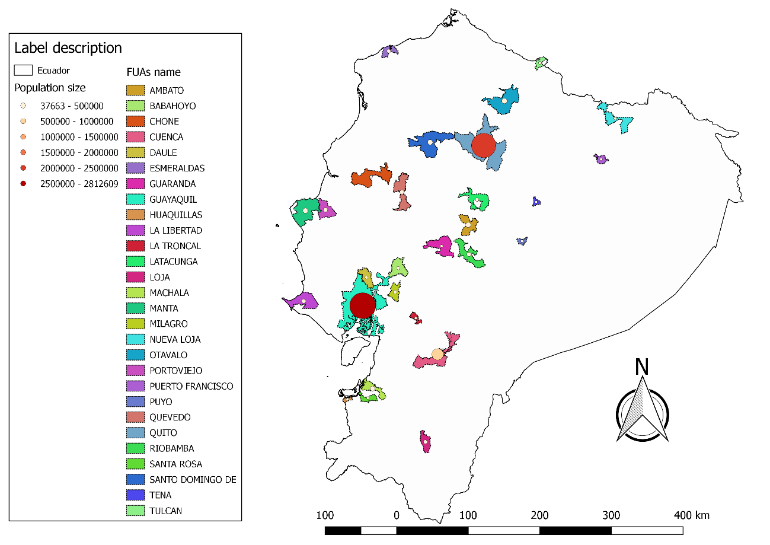
Source: INEC-Ecuador, and Obaco et al. (2017). Administrative boundaries and population based on the year
2010-2014
Notes: Elaboration by the authors
5 Data
We use information from the Ecuadorian censuses in order to explore the urbanization process over time. The first census was in 1950. The historical population comes from the National Institute of Statistical and Census (INEC)6 . To compare the FUAs of Ecuador with the international OECD dataset, we divide the OECD’s FUA in four groups: OECD, Europe, Colombia and Ecuador.
6 Urbanization in Ecuador
Figure 3 shows the total FUAs population according to their respective Ecuadorian censuses. The number of people living in FUAs has rapidly increased between 1950 and 2010. In 1950, the total FUAs population was around 40% of the total population, being mostly settled in the rural area. In 1972, the population living in FUAs reached around 50% of the total; and, in 1990, the population living in FUAs reached 60%. For 2010, the total population living in FUAs is around 63%. Thus, the highest increase in the urban population is presented from 1962 to 1982, around 0.77% per year.
Table 1 shows the average of the FUAs size distribution of the 28 FUAs according to the information gathered in the censuses. In 1950, the FUAs size distribution was below 0.5 million, composed of 26 FUAs below 0.2 million and 2 FUAs between 0.2 and 0.5 million. In 1990, the first FUAs of large metropolitan size appear, with one FUA between 0.5 and 1.5 million, 3 FUAs between 0.2 and 0.5 million, and 23 FUAs below 0.2 million. In 2010, the distribution was: 2 FUAs larger than 1.5 million, no FUAs between 0.5 and 1.5 million, 10 FUAs between 0.2 and 0.5 million, and the remaining (16 FUAs) were below 0.2 million.
| FUAs | 1950 | 1962 | 1974 | 1982 |
| FUAs greater than 1.5 M | ||||
| FUAs between 0.5 and 1.5 M | 544,506 | 812,374 | 1,173,644 | |
| FUAs between 0.2 and 0.5 M | 292,986 | 458,255 | 253,454 | |
| FUAs less than 0.2 M | 28,577 | 42,476 | 65,218 | 79,505 |
| no FUAs | 1,873,765 | 2,368,872 | 3,201,281 | 3,472,337 |
| Total Population | 3,202,757 | 4,476,007 | 6,521,710 | 8,060,712 |
| FUAs | 1990 | 2001 | 2010 |
| FUAs greater than 1.5 M | 1,611,884 | 2,028,966 | 2,436,027 |
| FUAs between 0.5 and 1.5 M | 1,376,630 | ||
| FUAs between 0.2 and 0.5 M | 245,632 | 284,534 | 291,813 |
| FUAs less than 0.2 M | 80,529 | 91,241 | 86,048 |
| no FUAs | 4,070,608 | 4,566,649 | 5,316,535 |
| Total Population | 9,648,189 | 12,156,608 | 14,483,499 |
Source: INEC, Ecuador
Notes: Elaboration by the authors
Figure 4 presents the average of the urban primacy of the FUAs in Ecuador for the period 1950-2010. We can observe the primacy of the two largest FUAs, Guayaquil and Quito during the whole period of time. However, in the most recent decades, the urban population has been mainly driven by the small FUAs, while the largest cities have grown slowly. For example, from 1962-1982, the largest urban population change was experienced in the Amazon and Coastal cities.
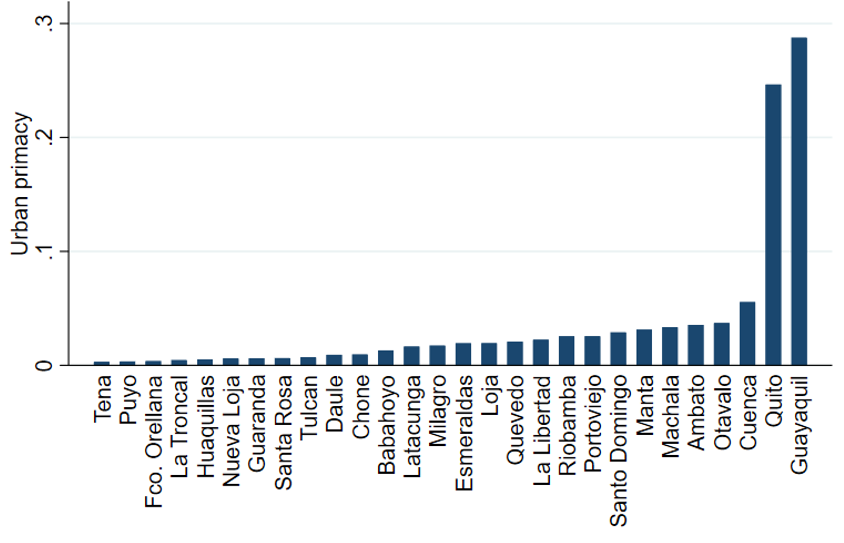
Source: INEC, Ecuador
Notes: Elaboration by the authors
7 The international context
Figure 5 shows the composition of the Ecuadorian FUAs system and a comparison to OECD countries, Europe, and Colombia in the year 2014. The comparison to Colombia is relatively important because Ecuador and Colombia share borders7 . 53 FUAs were identified in Colombia. As we can see, both systems are quite homogeneous. The Ecuadorian urban structure is still growing, and this growth is based on the small and medium sized FUAs (lower than half million inhabitants). If we compare the FUAs in Ecuador identified with the minimum threshold applied by the OECD, the same structure of these FUAs is based on the small FUA size. Additionally, a weak composition of metropolitan size (between 0.5 and 1.5 million inhabitants) is observed.
Clearly, Ecuadorian FUAs structure follows the international pattern. Europe is the exception since it has a more diverse composition. Furthermore, like Ecuador, Colombia has larger administrative boundaries compared with the real extensions of the urban cores.
Figure 6 shows the share of population contained in the FUAs of metropolitan size with respect to the total population by country. When the FUAs of metropolitan size (Guayaquil and Quito) in Ecuador are compared with 290 FUAs of metropolitan size of 32 countries, the Ecuadorian metropolitan areas are below the global average, and even below their Latin America partners (Colombia, Chile, and Mexico)8 . The same results are obtained when we compared with the 20 FUAs of different threshold.

Source: Information taken from OECD and INEC, Ecuador
Notes: Elaboration by the authors
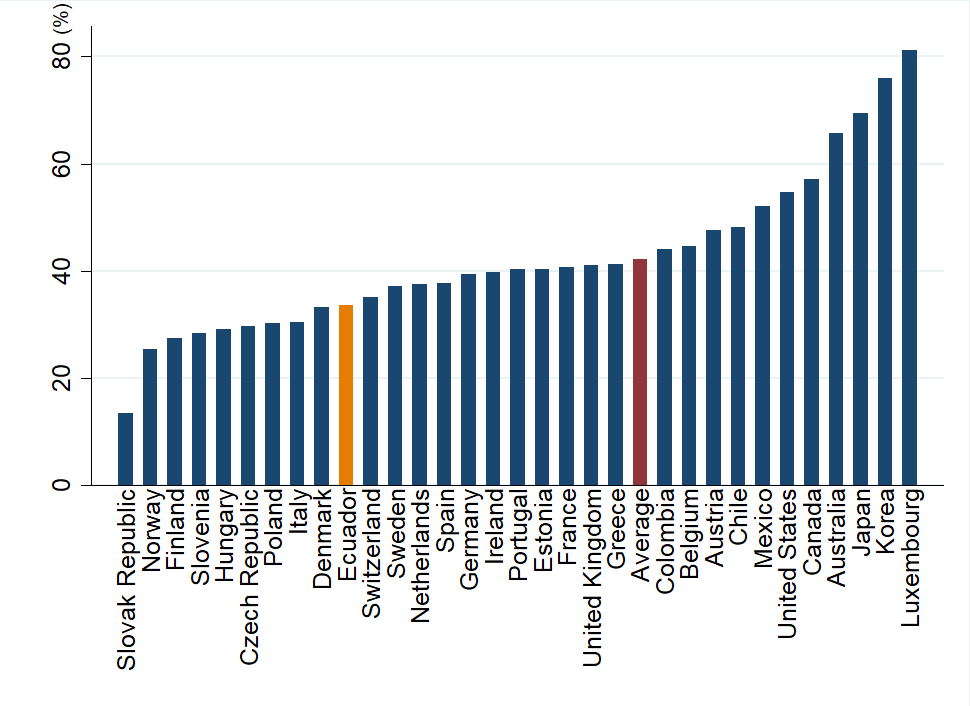
Source: Information taken from OECD and INEC, Ecuador
Notes: Elaboration by the authors
8 Conclusions
This work presents the urbanization process of Ecuador using the concept of Functional Urban Area and also compares with the international context. As for the urbanization in Ecuador, we part for two main considerations. First, the Ecuadorian official definition of urban, which is basically the population living in the head of the canton, does not approach an international conceptualization of urban areas nor FUAs. Second, the lack of commuting data does not allow application of any standard functional delimitation of urban areas in this country. These two important facts are limitations for and adequate planning of urban areas.
Later, we analyze 28 FUAs identified in Ecuador. Most FUAs are small size, one of medium size, and two of large metropolitan sizes in Ecuador. The largest increase of the urban population was during the period of 1962-1982. Additionally, the two largest cities, Guayaquil and Quito, remain larger over time, although the urban growth is mainly driven by the small FUAs in the last decades. This is important because it could show some trend to the decentralization of the urban system.
Next, we compare the data of Ecuador with the international database of the OECD. The FUAs of Ecuador also follow the composition of the urban structure of Colombia and the whole sample of the OECD composed mainly of small FUAs size. Moreover, the largest two Ecuadorian cities are below the average of the metropolitan FUAs of the OECD.
Finally, we highlight the importance of standardizing the concept of urban areas to give a better comparison among countries. In this line, the OECD presents an important advance in the collection of data shown in this work.
References
Adams JS, VanDrasek BJ, Phillips EG (1999) Metropolitan area definition in the United States. Urban Geography 20[8]: 695–726. CrossRef.
Ahrend R, Farchy E, Kaplanis I, Lembcke A (2017) What makes cities more productive? Evidence from five OECD countries on the role of urban governance. Journal of Regional Science 57[3]: 385–410. CrossRef.
Brezzi M, Piacentini M, Sanchez-Serra D (2012) Measuring metropolitan areas: A comparative approach in OECD countries. In: Fernández Bazquez E, Rubiera Morellón F (eds), Defining the Spatial Scale in Modern Regional Analysis: New Challenges from Data at Local Level. Advances in Spatial Science, Springer, 71-89. CrossRef.
Casado-Díaz JM, Coombes M (2011) The delineation of 21st century local labour market areas: A critical review and a research agenda. Boletín de la Asociación de Geógrafos Españoles 57: 7–32
Coombes MG, Green AE, Openshaw S (1986) An efficient algorithm to generate official statistical reporting areas: The case of the 1984 travel-to-work areas revision in Britain. Journal of the Operational Research Society 37: 943–953. CrossRef.
Duranton G (2015) A proposal to delineate metropolitan areas in Colombia. Desarrollo y Sociedad 75: 223–264. CrossRef.
Ferreira JA, Condessa B, Castro e Almeida J, Pinto P (2010) Urban settlements delimitation in low-density areas. An application to the municipality of Tomar (Portugal). Landscape and Urban Planning 97[3]. CrossRef.
Fox KA, Kumar TK (1965) The functional economic area: Delineation and implications for economic analysis and policy. Papers and Proceedings of the Regional Science Association 15: 57–85. CrossRef.
Glaeser EL, Henderson JV (2017) Urban economics for the developing world: An introduction. Journal of Urban Economics 98[1]: 1–5. CrossRef.
Matano A, Obaco M, Royuela V (2018) What drives the spatial wage premium for formal and informal workers? The case of Ecuador. AQR-IREA working paper (6): 35
Obaco M, Royuela V, Vítores X (2017) Computing functional urban areas using a hierarchical travel time approach: An applied case in Ecuador. AQR-IREA working paper (5): 46
OECD – Organization of Economic Cooperation and Development (2012) Redefining urban: A new way to measure metropolitan areas. OECD Publishing, Paris
OECD – Organization of Economic Cooperation and Development (2013) Definition of functional urban areas (FUA) for the OECD metropolitan database. OECD Publishing, Paris
OECD – Organization of Economic Cooperation and Development (2015) OECD urban policy reviews: China. OECD Publishing, Paris
OECD – Organization of Economic Cooperation and Development (2016) Making cities work for all. Data and actions for inclusive growth. OECD Publishing, Paris
OECD – Organization of Economic Cooperation and Development (2018) OECD urban policy reviews: VietNam. OECD Publishing, Paris
Pesaresi M, Melchiorri M, Siragusa A, Kemper T (2016) Atlas of the human planet 2016: Mapping human presence on earth, with the global human settlement layer. European Commission, EUR – Scientific and Technical Research Reports
Puderer H (2008) Defining and measuring metropolitan areas: A comparison between Canada and the United States geography. Geography working paper series defining, 92, 1-12
Schmidheiny K, Suedekum J (2015) The pan-European population distribution across consistently defined functional urban areas. Economics Letters 133: 10–13. CrossRef.
UN – United Nations (2015) World urbanization prospects: The 2014 revision. Department of Economic and Social Affairs, Population Division, (ST/ESA/SER.A/366)
Veneri P (2016) City size distribution across the OECD: Does the definition of cities matter? Computers, Environment and Urban Systems 59: 86–94. CrossRef.
Veneri P (2017) Urban spatial structure in OECD cities: Is urban population decentralising or clustering? Papers in Regional Science. CrossRef.
Villacis B, Carrillo D (2012) Estadística Demográfica en el Ecuador: Diagnóstico y Propuestas. Instituto Nacional de Estadística y Censos (INEC) Quito, Ecuador
 © 2018 by the authors. Licensee: REGION - The Journal of ERSA, European
Regional Science Association, Louvain-la-Neuve, Belgium. This article is distributed under the terms and conditions of the Creative
Commons Attribution, Non-Commercial (CC BY NC) license (http://creativecommons.org/licenses/by-nc/4.0/)
© 2018 by the authors. Licensee: REGION - The Journal of ERSA, European
Regional Science Association, Louvain-la-Neuve, Belgium. This article is distributed under the terms and conditions of the Creative
Commons Attribution, Non-Commercial (CC BY NC) license (http://creativecommons.org/licenses/by-nc/4.0/)
